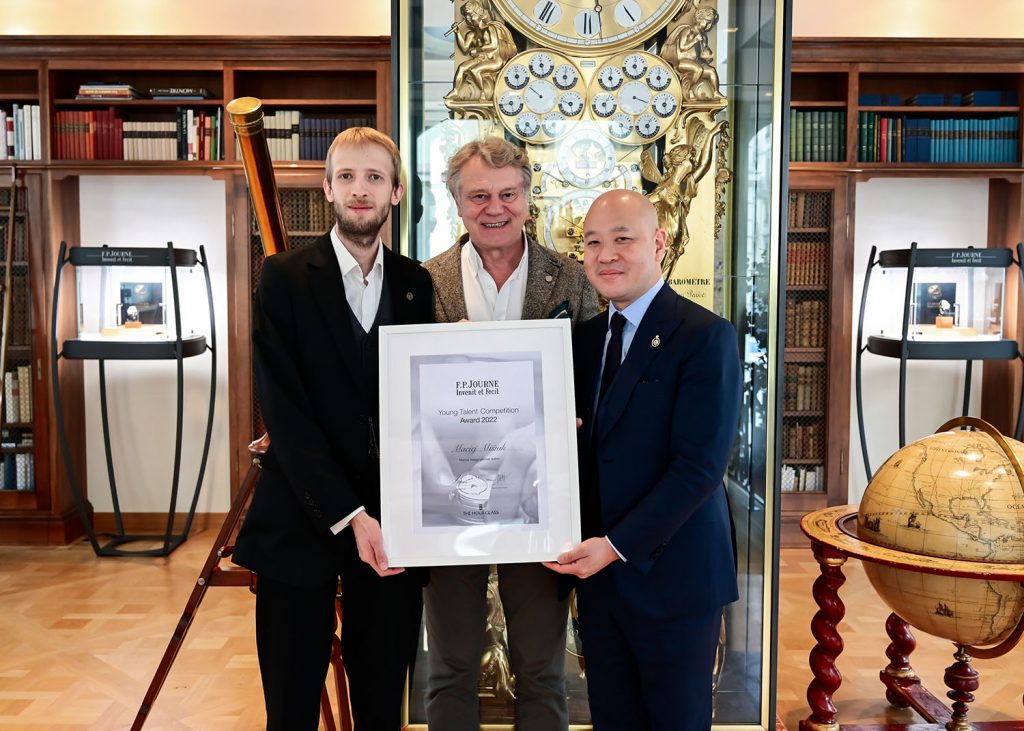News • 29 Nov 2022
Maciej Miśnik Wins the F.P.Journe Young Talent Competition 2022
The self-taught watchmaker from Poland wins this year’s F.P.Journe Young Talent Competition with a unique marine chronometer made completely by hand.

The F.P.Journe Young Talent Competition
Since 2015, the F.P.Journe Young Talent Competition supports young watchmaking students and recent graduates to gain their foothold as independent watchmakers. With the support of The Hour Glass, the winner receives CHF 20,000 to purchase watchmaking tools and finance their horological project.
About Maciej Miśnik

Based in Warsaw, Poland, Maciej Miśnik is a Physics graduate and a self-taught watchmaker, and watchmaking is in his blood – his grandfather, great-grandfather, and great-great-grandfather were all watchmakers.
“I wasn’t quite 2 years old when I destroyed my first Cuckoo clock. Ever since then, clocks, watches and tools have never left me.”
Passing his journeyman exam in the Masovian Chamber of Crafts and Entrepreneurship in Warsaw in 2018, Maciej Miśnik built his first watch in 2019 – a simple chronograph wristwatch based on parts from a pocket watch.
The Winning Watch
Maciej Miśnik’s entry, a marine design pocket watch with tourbillon and detent escapement, has a deeply personal link.
“My father is a seaman. Ever since my childhood, I have liked shining brass marine devices, especially clocks. I wanted to have a small marine chronometer watch that I could put into my pocket, so I decided to make a pocket watch with a tourbillon and detent escapement. For me, precision poising the balance wheel is a challenge, so I used a tourbillon to solve the problem.”

Inspired by marine chronometers, Miśnik’s pocket watch features a brass case, with contrasting silver pendant and bow. Components were made in Miśnik’s workshops, on basic lathes, milling machines, and using hand tools. The steel hands were thermally oxidized blue, visually harmonising with the black indexes on the silver dial.
The watch took about 8 months and 1,000 hours of work to build, as Miśnik opted to not use a CNC technology at all to make the watch.
“I did not use a CNC machine for 2 reasons: first, I think that if we say a watch is ‘hand made’, it has to be hand made, not made on a CNC machine and hand finished. Otherwise, it would be only hand-finished, and manufactured on a machine. I know many factories do this, but I can’t change that. I would like to point out that I’m not an enemy of mechanisation of production. It’s OK, but we have to be honest. The second reason is CNC machines are extremely accurate and reproducible, so, in my opinion of course, a watch cannot be unique. It can be beautiful, precise, amazing, but not unique.”
The result of this decision is Miśnik facing massive challenges in self-control and self discipline. “In just a few seconds you can destroy 3 days of work,” remarked Miśnik.
Maciej Miśnik Explains the Technical Aspects of the Watch

“As in marine deck chronometers, a pivoted detent escapement was used. Oscillation frequency of the balance wheel is 2 Hz. It is well known that detent escapement has good friction properties but it is not shock resistant. Due to this, I decided to make a pocket watch instead of a wristwatch. Additionally, the watch was equipped with a tourbillon thereby reducing the problem of poising the balance. Two barrels are used to ensure sufficient torque. A major problem with watches using a tourbillon is the inertia of the cage. For this reason, the tourbillon cage components are very thin and delicate to reduce the inertia. The cage is very heavy, weighing 2 grams, but the problem of inertia was reduced. In the escape wheel, the pinion and the wheel are separated and connected via a bronze hairspring. There is a sleeve with two rubies in the wheel, which runs on the steel axle of the pinion. The hairspring is arranged in such a way that it holds the wheel on the pinion (the wheel does not fall out). As soon as the cage is stationary, the escapement wheel is released. The escapement wheel moves and the cage begins to rotate. When the escapement wheel stops on the ruby, the cage continues to move and winds up the hairspring, losing its kinetic energy, and then slightly backs up. The backing up of the cage results from its high inertia and the reaction force of the hairspring. In most tourbillon watches, the cage stops with the escapement wheel, causing a temporary high force on the escapement elements and undesirable vibrations. In the case of the presented solution, a hairspring absorbs the vibrations, similar to solutions proposed for example by Derek Pratt, Karol Roman etc. The balance wheel is equipped with a Breguet-overcoil spring. There is no regulator on the hairspring due to chronometric properties. Two screws on the balance wheel maintain regulation of the oscillation period. Other screws are used to poise the balance wheel. The tourbillon cage is also poised, by a silver counterweight. Silver was used due to its high density.”
“The presented watch is made of raw metals. No elements have been electro painted or plated. Only the hands and three screws were thermally oxidized to blue. Sulphide was grown on silver elements, this is what gives this darker look to the dial and to the small plate with the signature. As previously written, I made most of the parts myself. Every part was finished by hand. In my workshop were not made: the watch chain, glass, 18 ruby bearings, balance hairspring, 2 mainsprings and 28 of 40 screws. I did not engrave the signature; it was made by a professional engraver.”
The Hour Glass is proud to support the F.P.Journe Young Talent Competition. Submissions for the 2023 Young Talent Competition are now open.











